FF8 (PS/JP) Research
- 2021/04/19
- ゼルカード目押しツモの補助スクリプト(English)及びFC01版(暫定)(English)にgame_fpsオプションを追加。Windows7(61fpsで動く)に対応したかも。
- スクリプトの類をgithubへ引っ越し。
- 2021/03/08
- ゼルカード目押しツモの補助スクリプト(English)及びFC01版(暫定)(English)のレアカードタイマーが動作しなくなっていた(str2patternメソッドがエラーを吐く)のを修正。
- 2021/01/24
- ゼルカード目押しツモの補助スクリプト(English)にFC01版(暫定)(English)を追加したついでにちょっとだけ変更。
- カード乱数の漸化式を修正(0x10dc0→0x10dcd)。
- 2017/09/01
- フィールドマップの歩数エンカウント内容の決定方法に英語版(適当)を追加。
- 2017/08/30
- フィールドマップの歩数エンカウント内容の決定方法を追加。
- 2017/05/12
- ゼルカード目押しツモのゼルカード1戦目押し用資料にX-ATM092(撃破)を追加。
- 2017/03/06
- 敵のAIスクリプト解析にSteam版(only in English)を追加など。
- 2016/12/17
- ゼルカード目押しツモに補助スクリプトのオプションの説明を追加。
- 2016/10/27
- ゼルカード目押しツモの補助スクリプトの致命的なバグを修正。
- 2016/10/26
- ゼルカード目押しツモの3人アップ視点一覧をゼルカード1戦目押し用資料に統合。補助スクリプトを更新・ようやっとEnglishに対応。
- アルティミシア戦(ほぼ)ロスなし初期パーティ固定法の補助スクリプトを更新・Englishに対応。
- 2016/10/23
- ゼルカード目押しツモに全1人アップ・3人アップ視点一覧を追加。
- 2016/10/20
- ゼルカード目押しツモにちょくちょく追記。
- 英語版(まだ見出しとカードだけ)を作成。
- 2016/10/18
- ゼルカード目押しツモにディアボロスカードなしゼルママ戦詰め手順を追加。
- 2016/10/15
- ゼルカード目押しツモにそして1戦ツモへ…を追加。補助スクリプトを更新、ゼルカード1戦目押し用資料を追加。
- 2016/09/27
- 戦闘からの逃走を追加。
- 自動回復・パーティ変更ポイント一覧を追加。
- 2016/09/26
- 敵のAIスクリプト解析に「RTA中主要な敵のAI」シートを追加など。
- 2016/09/25
- アルティミシア戦(ほぼ)ロスなし初期パーティ固定法にも〜っと!参考動画を追加。
- 2016/09/01
- 魔法消滅シミュレータをURLクエリによって魔法リスト指定可能にした。
- 2016/07/10
- ゼルカード2戦目押しツモを追加。あと初期パーティもゼルカードもJavaScript版は作らないと思います。
- 2016/07/02
- 敵のAIスクリプト解析をそこそこまともなものに更新。
- 2016/06/28
- 敵の魔法消去行動の偏りを追加。
- 2016/06/24
- アルティミシア戦(ほぼ)ロスなし初期パーティ固定法を追加。長い…
- HP割合とCrisis LevelのグラフのCL 1~4を、256ではなく「CL 1..4」(ややこしいな)を分母とする割合で示すよう変更。ついでにグラフに説明を追加。
- 2016/06/17
- HP割合とCrisis Levelとプロパゲーターのドロップを追加。
- 2016/06/04
- カーウェイ邸番号探索スクリプトにJavaScript版を追加。
- 2016/06/02
- カーウェイ邸番号探索スクリプトを追加。
- 2016/05/27
- モンスターAIスクリプト解析を追加。
Battle formation of step encounters is determined by following 3 factors:
- The field map that the step encounter occured
- The number of time that step encounters occured ever
- The battle formation (Encounter ID) of previous step encounter
- In field map, 4 battle formations are associated with each map (you can check them by Deling's Encounter Tab and FF8/Encounter Codes - QhimmWiki).
For instance, on the first map in Fire Cavern, battle formations are set as follows:
- ID 87: 1 Buel
- ID 87: 1 Buel
- ID 88: 1 Bomb
- ID 92: 2 Red Bat + 1 Bomb + 1 Buel
- Based on a RNG table and "the number of time that step encounters occured ever", a formation is selected with a probability with 50%, 25%, 18.75%, 6.25% in order from the top of 4 formations.
- However, if the selected battle formation (Encounter ID) equals to "the battle formation (Encounter ID) of previous step encounter", below of it is selected (this re-selection process is repeated until the last).
- "The number of time that step encounters occured ever" and "the battle formation (Encounter ID) of previous step encounter" are not updated by other than "step encounters in field map" (IOW, random encounters in world map and boss battles).
- "The number of time that step encounters occured ever" and "the battle formation (Encounter ID) of previous step encounter" are not saved in savegames. Just like Field RNG, they are not initialized by software reset and are initialized with 0 by hardware reset.
The RNG table is as follows (BTW, this is exact same as Danger Limit Table):
7 182 240 31 85 91 55 227 174 79 178 94 153 246 119 203
96 143 67 62 167 76 45 136 199 104 215 209 194 242 193 221
170 147 22 247 38 4 54 161 70 78 86 190 108 110 128 213
181 142 164 158 231 202 206 33 255 15 212 140 230 211 152 71
244 13 21 237 196 228 53 120 186 218 39 97 171 185 195 125
133 252 149 107 48 173 134 0 141 205 126 159 229 239 219 89
235 5 20 201 36 44 160 60 68 105 64 113 100 58 116 124
132 19 148 156 150 172 180 188 3 222 84 220 197 216 12 183
37 11 1 28 35 43 51 59 151 27 98 47 176 224 115 204
2 74 254 155 163 109 25 56 117 189 102 135 63 175 243 251
131 10 18 26 34 83 144 207 122 139 82 90 73 106 114 40
88 138 191 14 6 162 253 250 65 101 210 77 226 92 29 69
30 9 17 179 95 41 121 57 46 42 81 217 93 166 234 49
129 137 16 103 245 169 66 130 112 157 146 87 225 61 241 249
238 8 145 24 32 177 165 187 198 72 80 154 214 127 123 233
118 223 50 111 52 168 208 184 99 200 192 236 75 232 23 248
pseudo code (Ruby-like):
$prev_step_encounter_id = 0
$step_encounter_number = 0
def step_encounter
# add number before the determination of battle formation
$step_encounter_number = ($step_encounter_number + 1) & 0xff
rnd = RND_TABLE[$step_encounter_number]
if rnd < 128 && current_map_encounter_ids[0] != $prev_step_encounter_id
id = current_map_encounter_ids[0] # 128/256 = 50%
elsif rnd < 192 && current_map_encounter_ids[1] != $prev_step_encounter_id
id = current_map_encounter_ids[1] # 64/256 = 25%
elsif rnd < 240 && current_map_encounter_ids[2] != $prev_step_encounter_id
id = current_map_encounter_ids[2] # 48/256 = 18.75%
else
id = current_map_encounter_ids[3] # 16/256 = 6.25%
end
$prev_step_encounter_id = id
return id
end
- The number of time that step encounters occured ever (1 byte)
- 0x8005de23
- Encounter ID of previous step encounter (2 bytes)
- 0x8005de40
- RNG table for the determination of battle formation [256]
- 0x800c54e8-800c55e7
- 4 battle formations associated with current field map [4]
- 0x800e3018-0x800e301b
- execution address (roughly)
- 0x800a7e48-0x800a7ef4
- RNG subroutine (called from 0x800a7e48)
- 0x800a7c64-0x800a7c8c
自動回復・パーティ変更等のポイント一覧
回復・蘇生・治療・GF解除・パーティ変更・パーティ編成画面。
戦闘からの逃走
- L2・R2の押下中、60f(1秒)ごとに逃走判定「戦闘乱数 <= しきい値」が実行され、その判定をパスすると逃走が成功する。
- 逃走判定の周期はバトルスピード設定の影響を受けない。
- しきい値は敵の一部を倒しても変化しない。
- バックアタック・先制攻撃をこちらがしたときは、L2・R2押下60fで確実に逃げられる。
- 「最悪値」はアイテムなどの窓を開たままいわゆる「ウェイト逃げ」をした場合のもの。チェンジなどの他の乱数消費要素を挟むとこれより遅くなる可能性がある(速くなる可能性もある)。
- 「期待値11.54s」と「最悪値41s」が、バックアタック・先制攻撃を受けた時の撃破/逃走判断の一助になれば幸い。
| 戦闘の種類 | しきい値 | 逃走に掛かる時間 | 備考 |
|---|
| 期待値 | 最悪値 |
|---|
| バックアタック・先制攻撃 | 255 | 1.00s | X-ATM092(修復中) |
|---|
| 通常エンカウント | 128 | 1.98s | 10s | ルナパン通過戦闘・トライエッジ・ティアマト |
|---|
| 被バックアタック・被先制攻撃 | 16 | 11.54s | 41s | |
|---|
戦闘乱数について
- フィールド乱数やカード乱数のような線形合同法ではなく、0~255の値がランダムに並べられた以下の乱数テーブルが用いられる。最後の202に達したら最初の99に戻る。
- 逃走判定のみならず戦闘中のあらゆるランダム要素の決定に用いられている。ただしカード乱数の適用されるエフェクトとカメラ視点は例外。
- 乱数の初期位置は戦闘ごとに変化する。初期位置は電源投入からの経過フレーム数に依存するため、その調整は恐らく不可能。
99 6 240 35 248 229 168 1 193 174 127 72 123 177 220 9
34 109 125 238 157 88 213 85 36 57 122 223 142 84 108 27
192 11 208 67 216 154 71 93 33 2 23 75 219 17 175 112
205 77 52 73 114 145 45 98 151 89 69 247 110 70 170 10
163 200 49 146 56 250 212 230 203 243 222 107 187 241 28 60
214 173 178 169 221 87 66 149 12 121 37 31 188 231 172 91
131 40 118 242 24 218 135 161 97 111 190 90 94 81 239 176
201 21 116 137 189 209 162 117 215 153 133 76 79 210 191 74
32 8 86 160 80 58 103 38 65 51 183 186 251 48 207 124
132 44 50 233 29 22 130 120 164 128 101 95 14 39 185 25
195 167 182 0 59 252 136 225 198 147 254 139 217 184 19 105
47 100 18 55 253 119 226 181 4 224 26 140 143 180 204 249
96 235 41 227 144 165 104 61 129 115 63 171 126 179 15 206
196 53 148 150 134 113 211 42 228 159 156 236 78 20 245 234
64 166 246 3 152 197 7 244 43 194 62 232 155 54 83 46
141 13 82 16 102 30 237 138 68 158 5 255 92 199 106 202
参考文献
- Final Fantasy VIII Battle Mechanics FAQ
- 10.3 Running away に逃走についての記述あり。
How to Get Zell Card with Timing
Since the Card RNG state is saved in savegames, we can practice with our savegame just before Ma Dincht.
- Timing Script (English version) requires Ruby to run. The 1st game method is also supported.
(added on 2016/12/17) When we use this Script for FF8 PC, we have to modify $option[:delay_frame] at line 55. Default value of 285 is for ps2 fast mode. On PC ver, around 75, I guess.
And when we use my Early Quistis for 20 Hz, we have to modify $option[:early_quistis] at line 43 from :luzbelheim to :pingval. Because the Card RNG state after the card game is different from after Luzbel's one (for 30Hz).
- Reference Video Since it seems to be confusing, the console screen is also included.
- Materials for timing on the 1st game I think all required information is covered.
(added on 2016/10/20) I had forgotten to write an important information. When we input the opening situation of the 1st game to the timing script and match it, the value in bracket in the column of "index" is the exact count, for exapmle, it is "*[574]*" in the case of videos in the materials. So we can use it as the right answer to check when we fail in counting.
Even when we use the 2nd game method, we can know the exact count by the same way. So if we input to the script from past recording just like the 2nd game method, we can also know the exact count in the past.
All "focused on 1" and "focused on 3" Angles because of my mistakes in specifying them integrated into Materials.
How to Get on the 1st Game (added on 2016/10/15)
It would be no longer an armchair theory that the way to take timing on the 1st game with counting EXACTLY how many times the Card RNG is used in battles, which I mentioned that there might be a possibility once. Though a grasp of the uses of the Card RNG in battles is required, if we look back recording of our current run and count the Card RNG during cutscenes which are commonly found among PS FF series, we won't feel burdened much.
Since the interval between Magical Lamp and Ma Dincht is not much enough to check up on counting in Diablos battle, it might be better to play with Ma Dincht before Diablos battle. In that case, the route is: Magical Lamp - Ma Dincht - Diablos.
This way saves about 40s compared to on the 2nd game. But it would be far more troublesome than on the 2nd game, which requires only inputs of Early Quistis pattern and the opening situation of the 1st game. Even if our count and the exact one differ only by 1, this way fails. That can be recovered on the next game, though.
The Notation without Diablos of the Game with Ma Dincht
This is for the case Zell card is drawn on the 1st game. So assuming that Ma Dincht has Zell card and there is not Draw pattern. Characteristics of Ma Dincht's AI is used to the order of placement that she never capture Geezard on the lower-right corner from the left-side of it and Gayla on the upper-left corner from the down-side of it except by Grat.
When we have initiative and Ma Dincht does't have Zell card, this procedure can't be applied because her 1st place changes. When we don't have initiative, by lack of Diablos, our winning rate is not 100% but perhaps more than 99%. If we place any card on wrong position, it is difficult to recover that and we might lose at the worst case.
| Player's Deck |
|---|
| Geezard, Red Bat, Gayla, Ifrit, Quistis |
| Order | Initiative | not Initiative |
|---|
| Win | Win | If a right-side value of the card on [Up] equals 1 |
|---|
| 1 | Red BatLower-Right | ZellUpper-Left |
|---|
| 2 | ZellRight | GeezardLower-Right |
|---|
| 3 | GeezardDown | Right |
|---|
| 4 | Center | IfritDown |
|---|
| 5 | IfritLower-Left | Up |
|---|
| 6 | Upper-Left | Red BatUpper-Right | GaylaLeft |
|---|
| 7 | GaylaLeft | Left | Center or Lewer-Left |
|---|
| 8 | Up | QuistisCenter | QuistisCenter > Upper-Right |
|---|
| 9 | QuistisUpper-Right | Lower-Left | Lower-Left or Upper-Right |
|---|
About the Card RNG
The Card RNG relates the follows:
- Decision of CPU's deck
- Decision of initiative of the card game
- Decision of player's deck when the Random rule is enabled
- Decision of positions of element when the Elemental rule is enabled
- Some card players' AI's (e.g. Trepie #1) hands
- Camera angles in battle
- Some effects in battle
The Card RNG Generation
The Card RNG is used not only in the card game but also in battle. And its state is increased by 1 per frame on the starting screen of the card game. The above factors make more difficult to specify it. It has the property such as the following:
- The Card RNG state (differs from the Field RNG's one) which is the basis of random numbers is computed by the recurrence relation: "Xn+1 = (Xn * 0x10dcd + 1) mod 0x100000000" with let the Card RNG state be X and its initial value be 1.
And the value between 0 and 32767 which is computed by "X / 0x2000" is used as a random number. It is also upper 15 bits of the Card RNG state.
- In addition, during the starting screen of the card game (Play/Exit), the Card RNG state is increased by 1 per frame. Even though choose "Play" at the fastest timing, it is increased by 10.
- Since the Card RNG state is saved in savegames, it is not initialized even by hardware reset.
Notice: There addresses are on JP/PS version.
- Subroutine of the Card RNG Generation
- 0x80023ce0
- Increment of the Card RNG state on the starting screen of the card game
- 0x800a4894
- The Card RNG state (4 bytes)
- 0x800773f4
For your information, Early Quistis stands on the following fact: When we play the card game soon after the beginning of the game and choose "Play" with 30/s autofire button, and that narrows down the Card RNG state to two values of 1+10=11 and 1+11=12.
The Card RNG is referred to as "RNG" in this Section.
How to Get on the 2nd Game
First, we specify RNG state with the opening situation of the 1st game. Second, based on it, we take timing to let her draw Zell card on the next game. And then Ma Dincht draws Zell card. The above means that we can get Zell card on the 2nd game with her.
If we never enter the screen of the card game between the beginning of the game or Early Quistis and Ma Dincht then choose "Play" with the autofire button such as Early Quistis (no need 30/s speed), we can limit RNG state to searchable range. And we can specify it with the opening situation, 5 cards in her Deck and which side has initiative, of the 1st game. Because she draws cards from among the wide range of level 1, 2, 4 and 5, when she doesn't have Zell card, there are 43P5 * 2 = 231,023,520 ways, 5 cards from among 43 (except PUPU) * initiative, of the opening situation. Therefore we can pretty certainly specify RNG state with it.
The probability that Ma Dincht draws her rare card is 10%. In that case, on the starting screen of the card game, the frame where she draws it continues for 19 frames with a period of 190 frames. When we have already specified the current RNG state, we can specify the "Rare Card Frames" of the next game too. So, in theory, if we take timing of 19 frames (about 0.32s) on the starting screen, we can let her draw Zell card.
But actually, because of environmental differences and reading time of CD-ROM, the range for timing is narrower. However, even if we fail to get Zell card by a failure of timing or drawn game, we can indefinitely continue to recover with repeat specifying RNG state with the opening situation of the failed game and taking timing on the next game over and over.
In theory, if we count EXACTLY how many times the Card RNG is used in battles until Ma Dincht, we can immediately take timing to get Zell card on the 1st game without one game to specify RNG state. But because RNG is used around 500~600 times from the beginning of the game to defeating Diablos, even if all uses of RNG are revealed, the way to get Zell card on the 1st game which requires counting all of them is unrealistic, I think. By any chance, there might be a possibility for that, though.
The Notation of the Game with Ma Dincht
- Ma Dincht's AI places cards according to simple order of priority as: "the number of capturable cards > the position in her deck (top > bottom) > the position to place (789456123 on numeric keypad)"
- Since Zell card (rare card) must be on the top of her deck, she places it first.
- It is able to patternize the order of placement by using her characteristic that she places the card on the top of her deck in the order of from the upper-left corner to right when there are no capturable cards.
No matter what cards Ma Dincht has, we surely win if we follow this procedure. As for Draw pattern, though we will occasionally win, draw with high probability. If we draw with her on the 1st game to specify the Card RNG state, we can save about 2s. But considering it is required to input her deck on the 1st game, it might be unfavorable that the draw which we can't see a list of her deck at the end of the game.
We can play with Ma Dincht also just after Dollet before Diablos. But I guess that the advantage that the time for reset is moved forward is removed by this timing method. So Diablos is used in the notation.
| Player's Deck |
|---|
| Funguar, Geezard (or whatever), Quistis, Diablos, Ifrit |
| Order | Initiative | not Initiative |
|---|
| Win | Draw | Win | Draw |
|---|
| 1 | FunguarUpper-Left | Upper-Left |
|---|
| 2 | Up or Left | FunguarLeft |
|---|
| 3 | DiablosLeft or Up | Up or Center or Lower-Left |
|---|
| 4 | Upper-Right | IfritLower-Right |
|---|
| 5 | IfritLower-Right | Up or Center or Lower-Left |
|---|
| 6 | Center | DiablosLower-Left or Center |
|---|
| 7 | QuistisRight | QuistisDown | Upper-Right |
|---|
| 8 | Lower-Left or Down | Right or Lower-Left | QuistisRight | GeezardRight of Diablos |
|---|
| 9 | GeezardDown or Lower-Left | GeezardLower-Left or Right | Down | Right or Down |
|---|
Relation with the Way to Get Quistis Card
On the way to get Zell card on the 2nd game, we specify RNG state and take timing of Rare Card Frames on the 2nd game based on it. But if we specify RNG state on the 2nd game too, while we never enter any battle between two games, we can take timing of Rare Card Frames on the 1st game with other card player after that. And that can be not only from Ma Dincht to other but also from other to her.
I considered whether it can be done or not to add a twist to the way to get Quistis card:
- Ma Dincht => Trepie #1
- It is impossible not to enter any battle between two games.
- (added on 2016/10/20) Since the uses of the Card RNG in battle are revealed, it became possible. But compared to Early Quistis:
- When we use the 1st game method, we can't have much enough time to check up on counting in Dollet battles.
- On the game with Ma Dincht, only Ifrit from among rare cards is available.
- When we play with him before Diablos, though about 28s are saved, only Zell and Ifrit from among rare cards are available.
- When we play with him after Diablos, Zell, Ifrit and Diablos are available. But saved time is only about 9s.
- Because it would be impossible to specify RNG state after the game with Trepie #1, we can't use timing method from the 2nd game.
Because of that, it would be not much worth adopting. And at the same time, I feel the greatness of Early Quistis. Besides, the timing script is not yet compatible with this way to use.
- Trepie #1 => Ma Dincht
- Possible. But Trepie #1's AI uses RNG to decide his hands. In the case of this type of AI, it would be impossible to specify RNG state after the game unless we use completely fixed pattern such as Early Quistis. At least, I can't think up myself.
- Trepie #2 or #3 => Ma Dincht
- Ma Dincht => Trepie #2 or #3
- Possible in both cases. But because the waste of time due to detour nearly equals to that of Early Quistis, there is no advantage in doing that purposely.
As above, in any case seems not to work well. In conclusion, when we want both of Zell and Quistis card, I think it is the best way to get Quistis card with Early Quistis and Zell card with timing method after Diablos.
References
- カードプレイヤーリスト - アルティマニア補遺
- About each card player.
- Deling
- Definition of each card player.
- Card Rule Spreading/Abolishing Mechanics and other RNG goodness - Final Fantasy VIII Message Board for PlayStation - Page 6 - GameFAQs
- Analysis of the Card RNG 6 years ago. OMG
敵の魔法消去行動の偏り
以下の敵の行動は、魔法を1種類以上所持しているキャラからランダムに1人を選択し、更にその所持魔法からランダムに1種類を選択し、ドリンクマジックとドローは1個、魔法消滅はその全てを消去する。
- オチューのドリンクマジック
- ゴーマニとグリーヴァのドロー
- グリーヴァとアルティミシア(3回目)の魔法消滅
しかしその魔法選択率は所持魔法のバトル配置次第で大変な偏り方をみせることがある。魔法選択処理はだいたいこんな感じ。所持魔法の走査に用いるindex(0-based)の初期値が「0~所持魔法の種類の数-1」の範囲内の値しかとらないことがポイントで、空欄の存在が選択率に大きく影響するアルゴリズムになっている。
def select_spell
index = rand(0..255) % kinds_of_spell
while true
spell = spell_inventory[index]
return spell if spell != :blank
index += 1
end
end
n種類の魔法を所持しているとき選択率の分布が一様(256分率だけど)になるのは、1ページ目の1段目から順にn-1番目の欄まで空欄が存在しない、またはn=1の場合のみ。それ以外の場合は全て偏りが発生し、少なくとも一番下にある魔法が選択から除外される。最も極端な例を挙げると、一番上にある魔法よりも上にn-1個以上の空欄が存在する場合、一番上にある魔法が必ず選択されるなんてことがある。しかしこの仕様を利用すれば、ラスボス戦において僅かな種類のダミー魔法でトリプルをはじめとする重要魔法を確実に守れるはずだ。ダミーa種>ダミー以外b種の順に配置する場合、一番上のダミーよりも上にb個以上の空欄があれば、ダミーが全て消滅するまでダミー以外が選択されることはない。
具体的な挙動はシミュレータを弄って確認してみてください。
アルティミシア戦(ほぼ)ロスなし初期パーティ固定法
かなりめんどくさいっす。
フィールド乱数について
FF8では乱数が用途別にいくつも存在し、そのひとつにフィールド上での雑多なものごとに関わるものがある。その乱数を「フィールド乱数」と呼ぶ。フィールド乱数が関わるものごとには例えば以下のようなものがある。
- NPCの挙動
- カードのルール変化
- ドローポイントのドロー量
- 列車の入力コード
- 列車奥の窓から見える電柱の数
- カーウェイ邸の番号
- タイマン戦ガルバディア兵の挙動・ダメージ
- ラグナ編ルブルムドラゴンの挙動
- アデル戦後ムービー中のスコールの挙動
- アルティミシア戦の初期パーティ
以下、この節でいう「乱数」は全て「フィールド乱数」を指すものとする。アルティミシア戦の初期パーティ決定にはフィールド乱数以外の種類の乱数は関わらないので。
フィールド乱数生成(物好き用)
フィールド乱数の元になる「乱数の状態」は、乱数の状態をXとおいてその初期値を1とする漸化式「Xn+1 = (Xn * 0x41c64e6d + 0x3039) mod 0x100000000」で計算される。そしてこの乱数の状態Xから「((X / 0x10000) mod 0x8000) mod 0x100」として計算された0~255の値がフィールド乱数として用いられる。これは乱数の状態Xの上位9~16bitにあたる。
擬似Rubyコードで表すとこんな感じになる。ちなみに乱数の状態を求める漸化式は初期値の決め方以外PS版DQ4やDQ7と全く同じもの。ただ単にメジャーかつシンプルなアルゴリズムだから被っただけなんだろうけどね。
$rng_state = 0x0000_0001
def field_rng()
$rng_state = ($rng_state * 0x41c6_4e6d + 0x3039) & 0xffff_ffff
return ($rng_state >> 16) & 0x7fff & 0xff
# 厳密にいうと & 0xff は返り値を受け取った呼び出し元で行っているが
end
以下は日本語版でのそれぞれのアドレス。乱数の状態はFF8 - Caraway Code retro-engineeringでSequenceと呼ばれている値と恐らく同じものだが、言語が異なるためアドレスも異なる。
- 乱数生成のサブルーチン
- 0x800382e8
- 乱数の状態の保存先(4byte)
- 0x8005510c
- フィールド乱数として用いられた値(1byte)
- 0x8005510e
自分の確認した限り、乱数の状態が「乱数の消費」と「ハードリセット(初期値の1に戻る)」以外の要素で変更されることはない。つまり、現在の乱数の位置を特定できれば以降の乱数は全て予測できる。……というか、既にそれはカーウェイ邸番号探索でされているけれど。
最終マップで行われていること
ラスボス直前の最終マップにいる間(視点切り替え後含む)は0.5秒経過するたび乱数が1個消費される。これを「空回し」と呼ぶ。ただただ消費されているだけで、なにかに使われるわけではない。
# map#:583, label:91 から一部抜粋
while true
wait(15/30s)
rnd()
end
アルティミシア戦の初期パーティは、開いた扉が静止した直後に乱数を1個消費して決定される。これを「最終パーティ選定」と呼ぶ。6C3の全20通りからランダムに選択されるが、「セリキ」のみ9/256≒3.5%で他は13/256≒5.1%である。
# map#:583, label:70 から一部抜粋&簡略化
temp = rnd()
# tempの範囲は0..255
if temp < 13
setparty(ゼスア)
elsif temp < 26
setparty(ゼスリ)
elsif temp < 39
setparty(ゼスセ)
elsif temp < 52
setparty(ゼスキ)
elsif temp < 65
setparty(アスリ)
elsif temp < 78
setparty(アスセ)
elsif temp < 91
setparty(アスキ)
elsif temp < 104
setparty(リスセ)
elsif temp < 117
setparty(リスキ)
elsif temp < 130
setparty(セスキ)
elsif temp < 143
setparty(アゼリ)
elsif temp < 156
setparty(アゼセ)
elsif temp < 169
setparty(アゼキ)
elsif temp < 182
setparty(リゼセ)
elsif temp < 195
setparty(リゼキ)
elsif temp < 208
setparty(セゼキ)
elsif temp < 221
setparty(リアセ)
elsif temp < 234
setparty(リアキ)
elsif temp < 247
setparty(セアキ)
else
setparty(セリキ)
end
ハードリセット後にアルティミシア城前のセーブデータから再開し、最後の道の移動と選択肢を最速で進行した場合のパーティは「ゼスキ」または「アスリ」になる。「ゼスキ」は最終パーティ選定に44個目の乱数が使用されたことを、「アスリ」は45個目が使用されたことを意味する。つまり44個目が空回しされるかされないかのタイミングで最終パーティ選定が実行されるというわけで、このことから最終マップを最速で進行した場合、マップinから最終パーティ選定までの空回し継続時間は0.5*44=約22.0sと考えられる。確実に45個目の乱数を適用したいときは空回しタイミングのちょうど中間をみて、滞在時間を約0.25s伸ばすといいだろう。45+n個目を適用したいなら0.5n+0.25s伸ばす。後述する方法でパーティを固定させるときもこの0.25sは必須である。
エミュレータ(ARBEX100606)と実機(PS版FF8日本語版・SCPH-90000(高速モード))では空回し継続時間に差があるようだったためこれは実機で調査した。なお、扉のテキストを送る最中も空回しは続いているため、テキスト長の異なる他言語版に22.0sをそのまま適用することはできない。
メニュー操作を最終マップで行うとき、メニュー開閉n回につき空回し時間が(n-1)*2fだけ伸びる。ただし扉に近すぎると伸び幅が大きい(超接近して1回開閉しただけで空回しが12f(0.2s)伸びたのを確認)。メニュー開閉を何度も繰り返すことなんて普通はないから、扉のすぐ傍でしない限りは最終マップでメニュー操作を行っても空回しへの影響はほぼないということになる。扉のテキスト送りが遅れるかもしれないが(□連射?)。
アデル戦後ムービー中の乱数消費
アデル戦後の時間圧縮ムービーが流れている最中、スコールはコントローラの入力次第で様々な動きを見せる。このときアニメーションが開始されるタイミングで△○×□↑↓←→のどのボタンも押されていなければ、乱数が1個消費され↑↓←→いずれかの動きがランダムに行われる。この乱数消費は画面に空が映った直後に開始され、途中鳥の大群に覆われてスコールが見えなくなった後も続き、画面がホワイトアウトする直前を最後に終了する。ムービー中終始無入力状態のときに消費される乱数の数は45個で、その周期は平均101f≒約1.68sである。「平均」と表現しているのは、乱数消費によるアニメーションの場合「→」が他の方向より4f長くなるからだ(方向キー入力時の動きの周期は常に100fなので、無入力時は動き1回につき平均1f遅れる計算になる)。
| ボタン | → | ← | ↓ | ↑ | ○ | □ | × | △ |
|---|
| アニメーションのフレーム数 | by 手動 | 100 | 100 | 100 | 100 | 108 | 116 | 108 | 116 |
|---|
| by 乱数 | 104 | 100 | 100 | 100 | - | - | - | - |
|---|
| 無入力時 rnd() & 3 | 3 | 2 | 1 | 0 | - | - | - | - |
|---|
# map#:351, label:8 から一部抜粋&簡略化
while true
animation = 0
# 押下されているボタンによってアニメーションが決まる
# 下にいくほど優先順位高
animation = 5 if keyscan(△)
animation = 6 if keyscan(×)
animation = 7 if keyscan(□)
animation = 8 if keyscan(○)
animation = 1 if keyscan(↑)
animation = 2 if keyscan(↓)
animation = 3 if keyscan(←)
animation = 4 if keyscan(→)
# △×□○↑↓←→どれも押されていない場合、
# フィールド乱数を消費して↑↓←→のうちどれかのアニメーションが選択される
animation = 1 + (rnd() & 3) if animation == 0
if animation == 5
animekeep(6)
elsif animation == 6
animekeep(7)
elsif animation == 7
animekeep(8)
elsif animation == 8
animekeep(9)
elsif animation == 1
animekeep(10)
elsif animation == 2
animekeep(11)
elsif animation == 3
animekeep(12)
elsif animation == 4
animekeep(13)
end
end
(ほぼ)ロスなし初期パーティ固定法
自分が考えているロスなしパーティ固定法とは、ムービー中のスコールの5~16回目の動きをみて現在の乱数の位置を特定し、20から45個目までの0~26の範囲で任意の数だけ乱数を消費することで目当てのパーティを選定させようというもの。うまく行けばロスは最終マップでの0.25sだけで済む。具体的にとる行動は以下の通り。
| 常時無入力時の乱数の番号 | ムービー中のスコール | パーティ固定のためのプレイヤーの行動 |
|---|
| 1~3 | 視認できない。 | 次に備えて何も入力しないようにする。オート連射も当然オフにする。テキストを送らなくてもタイムは落ちない。 |
|---|
| 4~15 | 視認できるようになる。 | 無入力状態を維持しつつ、乱数特定用の12回分の動きを記録する。12回目の動きを確認したらすぐ十字キーorアナログスティックをどの方向でもいいから入れ続ける。 |
|---|
| 16~19 | ゼルが邪魔になったりして視認しにくくなる。 | 引き続き方向キーを入れ続けて乱数消費を阻害しつつ、記録した動きから乱数の特定作業を行う。 |
|---|
| 20~33 | 画面が海中に切り替わったあと、また視認できるようになる。 | スムーズに特定できたなら、スコールが海に飛び込むムービー後に画面が海中へ切り替わる瞬間に合わせてコントローラから指を離し、無入力状態を「1.68*乱数を進めたい数 s」持続して乱数を消費させる。
特定に手間取ってそのタイミングに間に合わなかった場合は、スコールの動きをみて乱数消費の中間の辺りを見計らいコントローラから指を離す。
必要なだけ消費させたらまたボタンを押し続け(このときは△○×□でもよい)、乱数を動かさないようにする。 |
|---|
| 34~44 | 鳥の大群に覆われる。これ以降は全く視認できない。 |
|---|
| 45 | 画面がホワイトアウトする直前。 | ムービー中最後の乱数消費ポイント。ここを過ぎてもまだ必要なだけ乱数を消費できていない場合、残りの回数はドローポイントまたは最終マップで消費する。 |
|---|
| ムービー終了後 |
|---|
| ドローポイント or 最終マップ | 残りのn回を消費する。ドローポイントをn回調べる(1回/0.6s)か、最終マップで0.5*n s待機する。 |
|---|
| 最終マップ | 待機なり斜め移動なりして滞在時間を0.25s伸ばす。 |
|---|
ドローポイントを調べれば、パーティにドロー要員がいなかろうがアルティミシア城内でドローが封印されていようが既にそこからドロー済みであろうが、乱数が必ず1個だけ消費される。カウントにだけ集中できるので特定後の乱数消費手段の中では最も安全な方法といえる。調べるドローポイントはSeeD達の傍のトリプルか中庭のスロウがいいだろう。
乱数の範囲を1500~3500とかなり広くとって動きの重複を探索してみても一組も見つからなかった。これはつまり、RTA中の乱数の現在位置は、スコールの連続する12回の動きを見れば確実に特定できるということを意味する(はず)。さすが4^12通りだ、誕生日攻撃を喰らっても問題ないぜ。
しかしこの方法には手間が掛かる以外にも大きな問題があって、それは目当てのパーティに固定するのに手頃な乱数消費数で済むとは限らないというものだ。ハードリセットを伴うパーティ固定法ならば乱数が常に同じ位置にあることが保証されているからその心配はないのだが。……Disc3終了時のセーブ&リセットで乱数を初期化してアデル後ムービーで乱数を0~45個消費することでディスク交換ロスを吸収しつつパーティを全20パターンから選択できる、というセーブリセ再現の改善案みたいなボツ案もあった。
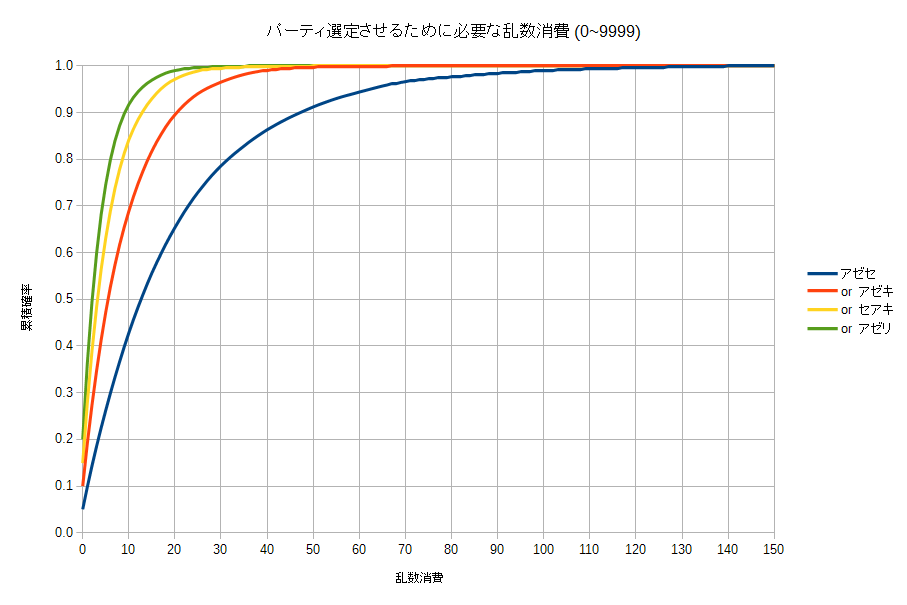
それはさておき、固定する目標に単一ではなく複数のパーティを設定し、その中で乱数の消費数が最も少ないパーティを採用することでこの問題の解消を試みる。左のグラフは乱数の範囲0~9999で目標パーティ数1~4のとき必要となる乱数消費の累積分布だ。パーティ数1のときの乱数消費の多さが目につく。ここではアーヴァイン+低Lvキャラの組み合わせとなるパーティを目標に設定しているが、唯一確率の低い「セリキ」を選択しない限りは他のパーティでもだいたい同じ結果になるはずだ。
速やかに乱数特定を終えムービーが終わるまでに乱数を26個消費できる場合、乱数消費を後に持ち越すことなくムービー中に済ませられる確率は目標パーティ数1では74.2%しかないが、2なら94.7%。3と4なら99%超でほぼ間違いなくロスなく済ませられる。また、特定に多少手間取って20個しか消費できない場合も目標パーティ数3なら97.2%、4なら99.0%である。
| 乱数消費 | アゼセ | or アゼキ | or セアキ | or アゼリ |
|---|
| 0~20個 | 65.4% | 89.6% | 97.2% | 99.0% |
|---|
| 0~26個 | 74.2% | 94.7% | 99.1% | 99.7% |
|---|
戦略レベルに影響が及ぶかもしれないが、手頃な乱数消費でパーティを引けない問題は目標パーティを3個以上設定すれば解消できる、と考えていいのではないだろうか。他にエンカウント歩数への影響とか実際のプレイでの乱数の位置はどこじゃだとかいろいろあるかもしれないけれど、とりあえずこんなところで。
参考文献
- Deling
- 神。オプコード「0e8 - RND」を検索すれば、ゲームのスクリプト中の乱数の使用箇所がわかる。最初に挙げた例もドローポイント以外はDelingで確認できるもの。調べれば更に面白いものが見つかるかもしれない。ただしpseudo-codeを読む際はなぜか二項演算子の左辺と右辺が反転している点に注意。オプコードの意味はFF8/Field/Script/Opcodes - QhimmWikiに載っている。
- PS版DQ4 2章エンドールメタルの乱数調整について:きほんはまる - ブロマガ
- 乱数の仕組みの解説について。
HP Rare and Crisis Level
Crisis Level = ピンチ度でした。
- Script
- Output
- グラフ
Graph
- 水色の太い線は、特殊技が使用可能になる確率を示している。
Aqua bold line shows the probability that Limit Break is available.
- 青~緑の線は、特殊技を使用したときにそれぞれのCrisis Level(以下CL)になる確率を示す。だからその和は1.0になる。
Lines from blue to green shows the probability Limit Break within each Crisis Level. So sum of them equals to 1.0.
- 例を挙げると、死者0人の状況(一番左上のグラフ)でHP20%のキャラにターンが回ってきたときは約24%の確率で特殊技が使用可能であり、そのキャラが特殊技を使用した際にCLが1の確率は約60%、2の確率は約40%、3と4は0%と読める。
For example, when no one is dead (graph on upper-left corner) and a character whose HP is 20% gets turn, he can use Limit Break by around 24%. And the probability of Crisis Level of the Limit Break equals to 1 is around 60%, equals to 2 is around 40% and as for both of 3 and 4, 0%.
| Dead | 0 | 1 | 2 |
|---|
| Normal |
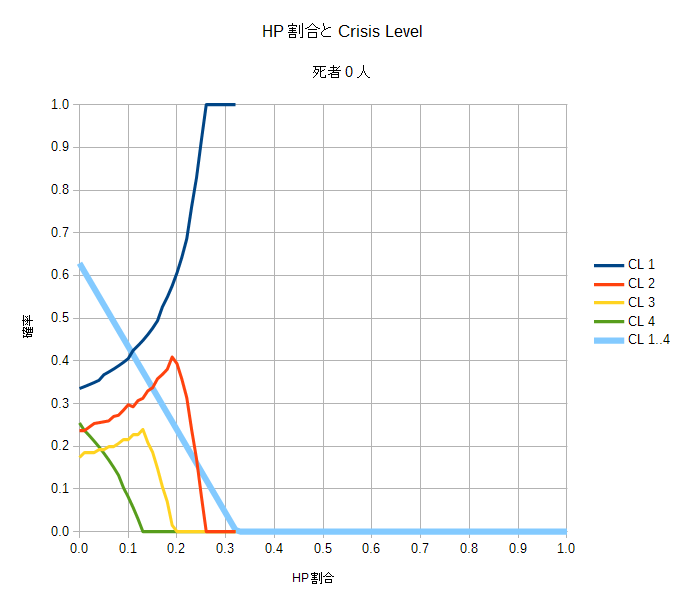 |
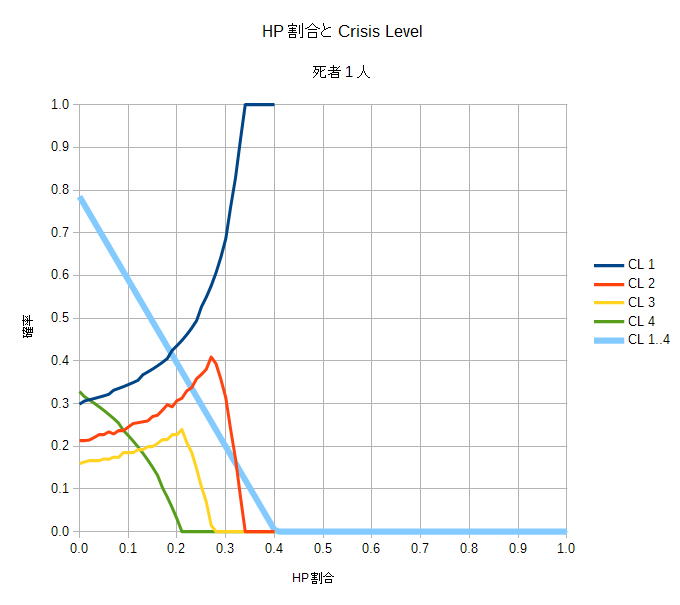 |
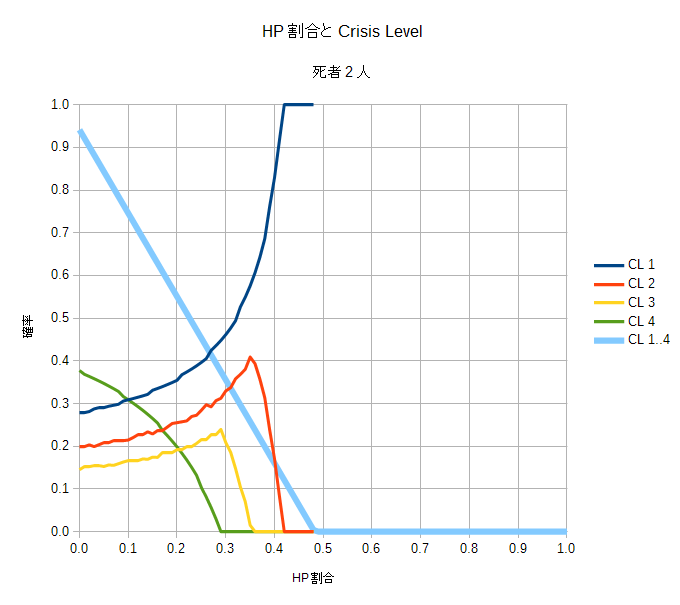 |
| Aura Status |
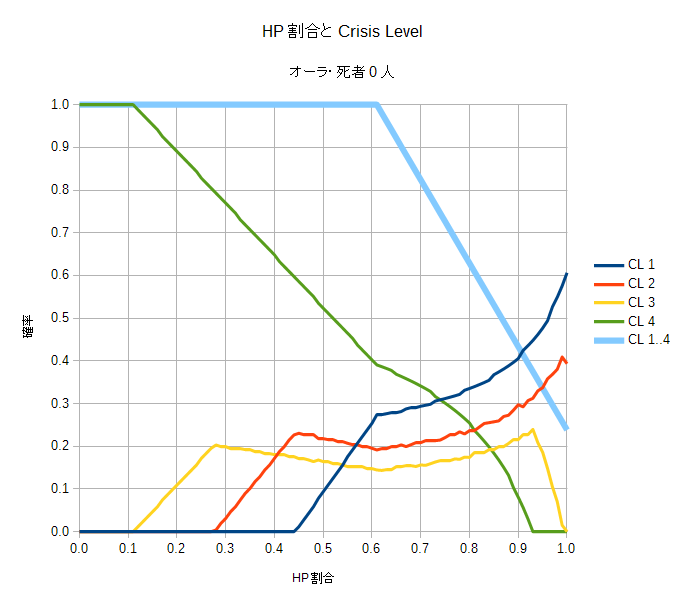 |
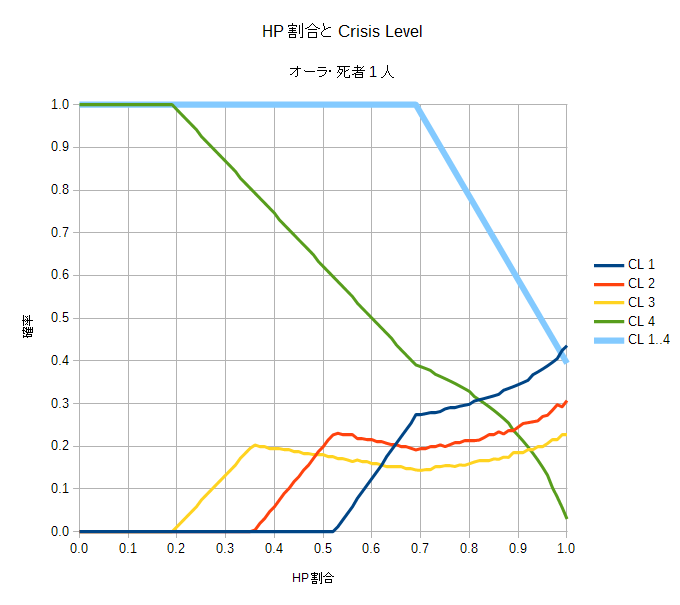 |
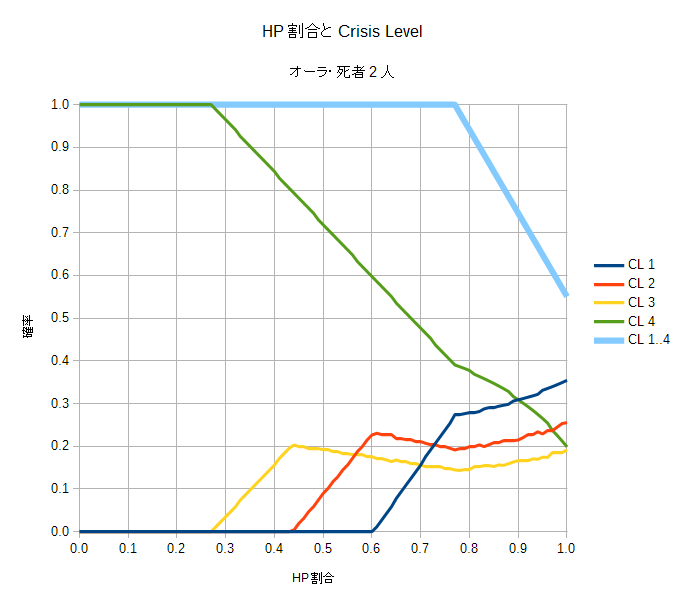 |
| Seifer |
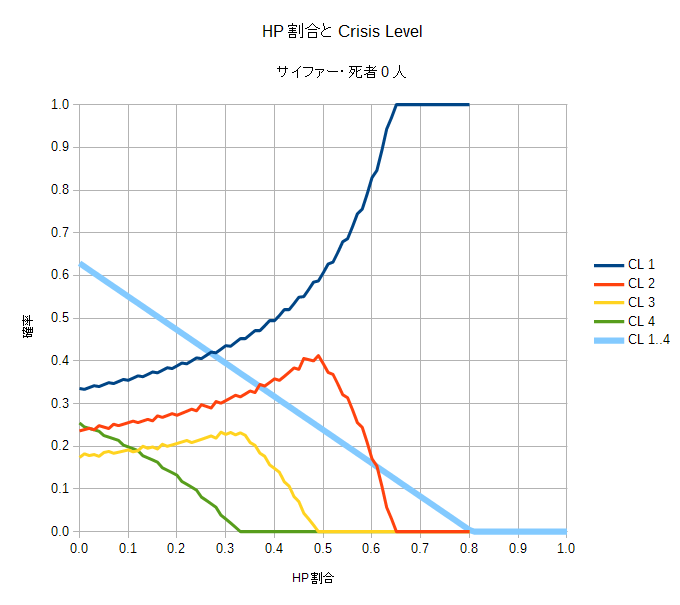 |
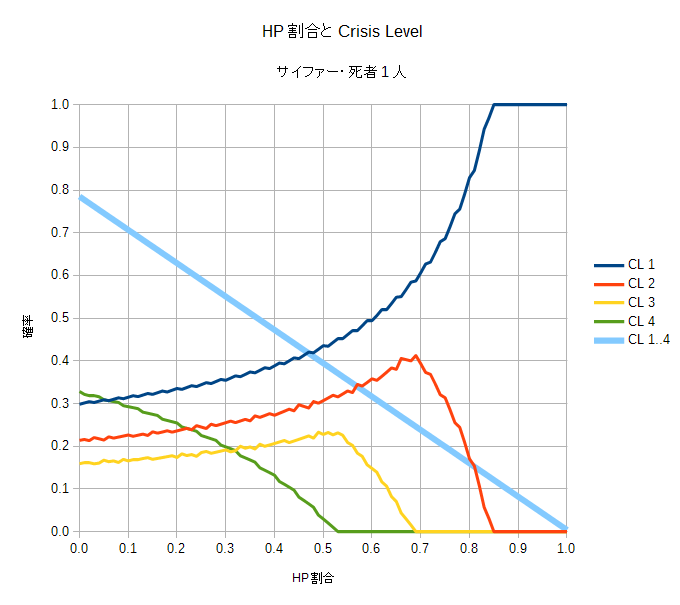 |
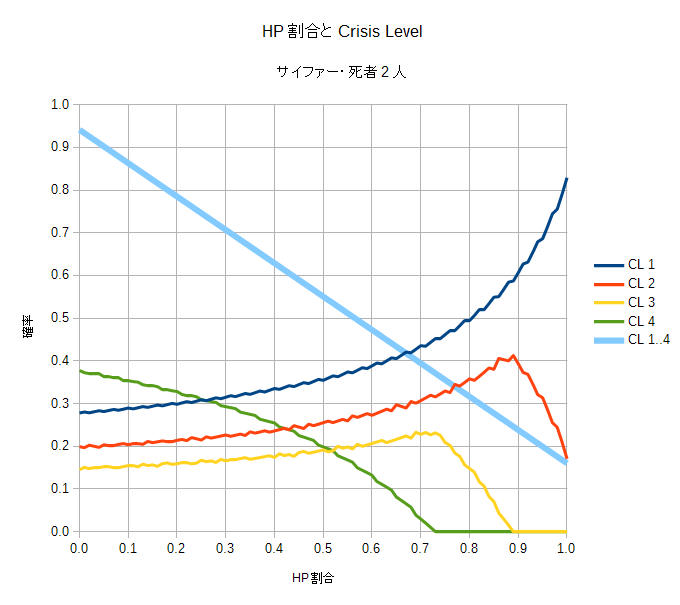 |
- スクリプトはFinal Fantasy VIII Battle Mechanics FAQで紹介されている計算式を元に書いた。
I wrote the script based on the formula written in Final Fantasy VIII Battle Mechanics FAQ.
- CLは味方にターンが回るたびに計算され、0~4の値をとる。
CL is computed every time a character gets turn and the value is within 0-4.
- CL>=1で特殊技が使用可能になり、メインキャラの特殊技はCLが高いほど高度なものになる。
Limit Break is usable when CL>=1 and higher CL means higher Limit Break of main characters.
- 通常はHP32%(サイファーのみ80%)以下になると特殊技が使用できる可能性が生まれるが、ちょうどそのときの確率は1/256である。
Basically, when HP comes to be less than or equal to 32% (only Seifer is 80%), the possibility of Limit Break is risen. But the probability at that time is 1/256.
- ここでは端折っているが、オーラ以外のST変化でもCLが高い値をとりやすくなるものがある。
Though it is abridged here, even some status except for Aura causes to get higher CL.
- より詳しい情報やCLと各キャラの特殊技との関連性はありがたいことにBattle Mechanics FAQの中で明確に示されているのでそっち参照。
More informations and relations between CL and each characters' Limit Break are thankfully written in Battle Mechanics FAQ explicitly. So refer to it.
Propagators' Drop Items
- Script
- Output
-
- ドロップ率は赤のみ(255+1)/256=100%。他は(192+1)/256≒75.4%。
Propagaters' Drop rate Only Red is (255+1)/256=100%. Other colors are (192+1)/256=~75.4%.
- プロパゲーター全8匹を撃破してオーラストーンが1個以上手に入る確率は約91.52%。紫のオーラストーンのドロップ率11/256と赤の178/256から求めることもできる(1-(1-11/256)^2*(1-178/256)^2≒91.5%)。
When we kill all 8 Propagaters, the probability that we get even one Aura Stone approximately equal to 91.52%.
We can compute it also from 11/256, Purple's drop rate of Aura Stone, and 178/256, Red's. (1-(1-11/256)^2*(1-178/256)^2=~91.5%)
カーウェイ邸番号探索スクリプト
日本語のPS版FF8でしか確認してないっす。以下特徴。
- 乱数生成の段階からシミュレートしている(キリッ
- 電車奥の窓越しの電柱・デリングシティNPCの両方或いは片方を用いて探索できる
- 見逃した値の入力を飛ばして探索できる
- 番号入力時に入れるべきコマンドを結果に出力する
- 自分に適した設定にカスタマイズできる…かもしれない
参考文献
- FF8 - Caraway Code retro-engineering
- 乱数の解析・デリングシティNPCによる番号特定方法
- ハードリセ無パスワード固定法について:ギルのブロマガ - ブロマガ
- 上記の日本語による解説
- Bienvenue ! - Hyperbolic World
- 電柱による番号特定方法
敵のAIスクリプト解析
psff8-enemy-ai.zip
- 2017/03/06
- Steam版(only in English)を追加。元のPS日本語版AIのディレクトリには”psjp-”を頭に付けた。
- 見落としていたアルティミシア(ドローポイント)を追加。この影響でミシア3などでのID指定のズレが直った。
- ゴーマニ・ドロマニ・バイセージの個体変数を命名(Steam版用)。
- イフリートのカウンターについての説明を修正。
- 2016/09/26
- OPコード24が「fill_ATB」とわかったのでAIを更新。
- それに伴いアルティミシア2のAI解説を少し変更。
- readme.odsに「RTA中主要な敵のAI」シートを追加。ただしややこしいのは省いてます。
- 変数名の「recieve」の綴りを「receive」に修正。
- 2016/07/02
- 更新履歴を書ききれないくらい一新。
- readme、OPコード・変数名・敵の行動・魔法一覧、アルティミシア戦詳細を添付。
- 不明なOPコードは18個から9個にまで減りました。
- 2016/05/27
- 見切り発車的な公開。不明なOPコードは51個中18個。









